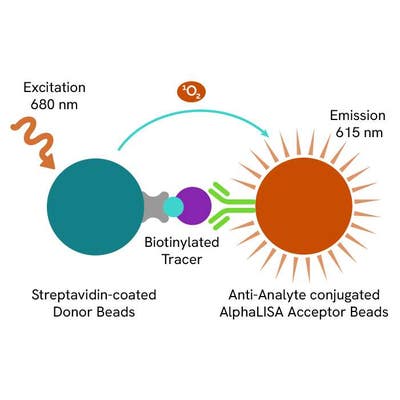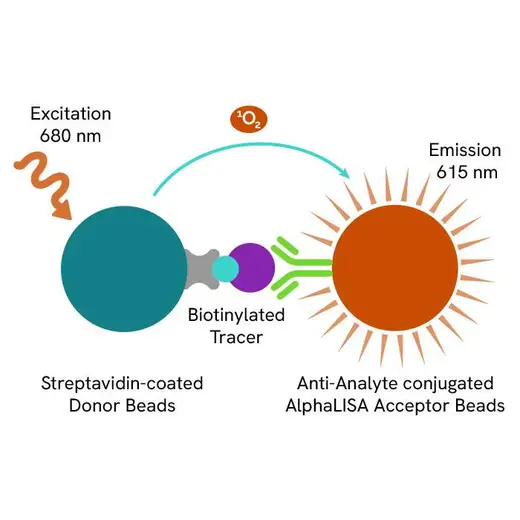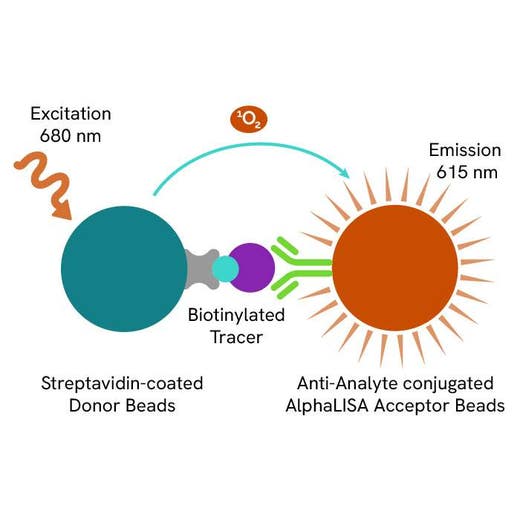
AlphaLISA IP-One Detection Kit, 1,000 Assay Points


AlphaLISA IP-One Detection Kit, 1,000 Assay Points






The AlphaLISA™ IP-One Kit is a competitive immunoassay for quantitative detection of IP1 in cellular lysates using Alpha Technology.
| Feature | Specification |
|---|---|
| Application | Second Messenger Detection |
| Sample Volume | 20 µL |
The AlphaLISA™ IP-One Kit is a competitive immunoassay for quantitative detection of IP1 in cellular lysates using Alpha Technology.



AlphaLISA IP-One Detection Kit, 1,000 Assay Points



AlphaLISA IP-One Detection Kit, 1,000 Assay Points



Product information
Overview
Inositol Monophosphate (IP1) is part of the group of phosphorylated inositols that play a key role in diverse cellular functions such as cell growth, apoptosis, cell migration, endocytosis, and cell differentiation. Inositol 1,4,5 triphosphate (IP3) signals the activation of Gq coupled-receptors, however, it's short half-life makes it challenging to assess for drug screening. IP1 is a downstream metabolite of IP3, which can be made stable by the introduction of Lithium Chloride (LiCl). As such its accumulation following Gq-coupled receptor-induced phospholipase C (PLC) cascade allows for the direct characterization of all types of compounds acting on Gq-coupled receptors.
Features:
- No-wash steps, no separation steps
- ELISA alternative technology
- Sensitive detection
- Broad sample compatibility
- Small sample volume
AlphaLISA technology allows the detection of molecules of interest in a no-wash, highly sensitive, quantitative assay. In an AlphaLISA assay, a biotinylated anti-analyte antibody binds to the Streptavidin-coated Donor beads while another anti-analyte antibody is conjugated to AlphaLISA Acceptor beads. In the presence of the analyte, the beads come into close proximity. The excitation of the Donor beads causes the release of singlet oxygen molecules that triggers a cascade of energy transfer in the Acceptor beads, resulting in a sharp peak of light emission at 615 nm.
Specifications
| Application |
Second Messenger Detection
|
|---|---|
| Automation Compatible |
Yes
|
| Brand |
AlphaLISA
|
| Detection Modality |
Alpha
|
| Product Group |
Kit
|
| Sample Volume |
20 µL
|
| Shipping Conditions |
Shipped in Blue Ice
|
| Target |
IP1
|
| Target Class |
GPCR
|
| Technology |
Alpha
|
| Therapeutic Area |
Metabolic
|
| Unit Size |
1,000 Assay Points
|
Video gallery

AlphaLISA IP-One Detection Kit, 1,000 Assay Points

AlphaLISA IP-One Detection Kit, 1,000 Assay Points

Resources
Are you looking for resources, click on the resource type to explore further.
G-protein coupled receptors (GPCRs) are crucial transmembrane proteins involved in cellular signal transduction.
This technical...
Atherosclerosis pathogenesis, cellular actors, and pathways
Atherosclerosis is a common condition in which arteries harden and...
Emerging pathways to neuroinflammation and neurodegeneration
Neurodegenerative diseases, such as amyotrophic lateral sclerosis...


How can we help you?
We are here to answer your questions.






























